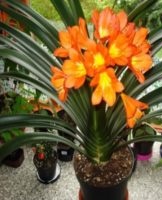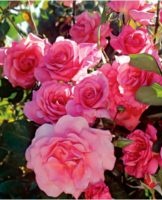Description and care of guzmania at home, transplantation and reproduction
The exotic Guzmania plant from the Bromeliad family grows mainly on mountain slopes and in tropical forests in South America and India. Over a hundred varieties and subspecies are known, some of which are grown as showy houseplants. Consider how to provide proper home care for guzmania so that it grows healthy and attractive.
Description and characteristics
The evergreen guzmania plant was first identified in 1802 by botanist Anastasio Guzman, after whom it is named.This popular culture is represented by many varieties suitable for growing in greenhouses, gardens and apartments. It grows in different ways - taking root in the ground or attaching itself to trees.
Guzmania leaves are bright green or variegated and form a funnel-shaped rosette. In the very center of the outlet, before flowering, brighter and more contrasting leaves appear.
The inflorescences of this plant are lush and bright, red, pink, raspberry, yellow or orange in color.
Rules of care
Guzmania flower will turn out beautiful if all care recommendations are followed.
Lighting and pot location
The tropical plant guzmania feels more comfortable in the east or west side of the room, where there are no direct rays of the sun that are harmful to it. It is undesirable to put a pot with a plant in too dark corners of the room, as this will negatively affect its development.
The most favorable lighting for guzmania in room conditions is diffused light penetrating through the glass. Before wintering guzmania, it is recommended to move the plant to the south. Otherwise, the lack of light can adversely affect subsequent flowering.
Dormant period
Local Guzmania does not have a distinct dormancy period. It is advisable to organize it with a reduction in sunshine hours and a decrease in indoor humidity, that is, during the autumn-winter period.
From October to February, you must:
- reduce the number of waterings - up to three times a week;
- suspend spraying and feeding;
- reduce the air temperature in the room to 18-20 ° C;
- Maintain lighting for 9 hours a day, using phytolamps or fluorescent lamps, if necessary.
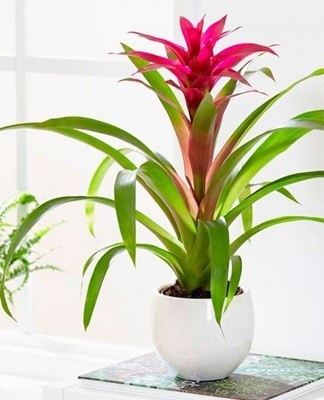
Temperature and humidity
Guzmania prefers moderately warm air between + 23-27 ° C in summer and + 16-20 ° C in winter. Lowering the temperature to 14 degrees leads to the appearance of susceptibility to diseases and causes deterioration of flowering. At all times of the year, the plant must be protected from drafts.
The humidity in the room where Guzmania grows should be high and be between 60-80%. Since the leaves of the plant absorb moisture from the air well, it should be watered with fresh water every day in the summer. On the hottest and most sultry days, this procedure should be carried out two to three times more often.
In the cold season, with intensive operation of heating devices, daily spraying with Guzmania leaves is also required.
How to water
The frequency of watering guzmania depends on the season. In the summer, especially during hot and dry periods, you need to water the plant every day or every other day, in the morning - in the center of the leaf outflow. In autumn and winter, watering the potted soil is necessary once a week. There are certain requirements for irrigation water. It should be slightly warm, previously decanted and filtered, since the plant does not tolerate chlorine and calcium impurities. Fifteen minutes after watering, excess water in the outlet should be drained to prevent rotting.
top dresser
Top dressing should be applied in spring and summer - when the growing season of guzmania passes. It is advisable to use a special fertilizer intended for bromeliads, but if it is not available, a universal fertilizer for indoor flowers may also be suitable.Once every two or three weeks, a liquid fertilizer should be applied to the exit of the plant when watering. It is not necessary to fertilize the soil, as there is a risk of root damage.
Bloom
Guzmania begins to delight flowers not immediately, but in the third or fourth year of life. Long green leaves with a dense texture form a rosette, which in appearance resembles an elongated glass. In the very center, a peduncle appears with small leaves and colored bracts in the upper part.
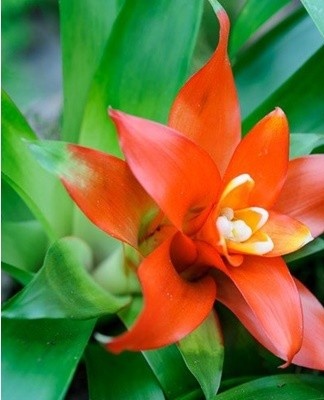
Flowering begins at the end of March and lasts from two to six months, depending on the variety of guzmania. The flowers themselves are light yellow in color, miniature in size and have a pleasant aroma. With the end of flowering, the life period of this flower also ends. In order for him to leave offspring, it is necessary to create the most favorable conditions.
Pot selection rules
Guzmania is characterized by a not bulky root system, and therefore it is possible to plant this plant in small pots. The selected container must be end-to-end to hold the roots of this crop. Since the plant is quite heavy, it is advisable to increase the stability of the pot - for example, move it to a planter and hang it up. In this case, it is necessary to regularly drain excess water after each watering. The optimal material for a pot and planter is ceramic.
Main issues
In the process of growing guzmania, novice flower growers may encounter difficulties. It is important to know them in advance in order to take effective measures.
Containment breach
Poor soil composition leads to a violation of the growth and flowering of indoor guzmania. You can solve this problem by choosing the optimal soil for the plant.It should have a light and airy structure. In addition, the following components should be added in equal parts:
- peat;
- coarse sand;
- leafy ground;
- turf land;
- sphagnum.

bad location
Too dark places in the apartment, as well as places exposed to direct sunlight, adversely affect the well-being of guzmania. It can dry out the tips of the leaves and stop flowering.
Bad nutrition
Food for indoor guzmania occurs mainly through the leaves. Do not apply fertilizer directly to the soil, as this causes burns to the root system.
Excess moisture
Too much water in the soil leads to rapid rotting of the roots and the base of the stem. To avoid this, you need to provide effective drainage in the pot. It is also necessary to drain the water from the outlet in time that the plant did not drink, if it did not evaporate.
Lack of water at the outlet
The lack of water at the exit of the plant, combined with too dry air, leads to drying of the leaves and roots. Therefore, you need to carefully monitor the general condition of the guzmania, and in case of evaporation of water in the funnel, add about a third.
Sunburn
Burning from direct sunlight causes the tips of the leaves to dry up and curl, as well as coating the entire surface of the leaf with unsightly brown spots.
Spraying with hard cold water
Guzmania, being a typical tropical inhabitant, does not tolerate cold hard water, especially if it contains particles of calcium and chlorine. Water for spraying the leaves should be defended for a day, then passed through a filter.

Low temperature
A drop in air temperature to 14-10 degrees threatens the lack of flowering of guzmania.
The peduncle has not been cut
Sometimes the owners of guzmania do not cut off the peduncle in time, waiting for the seeds of the plant to form. In this case, the process of forming new fresh shoots is significantly slowed down.
Transfer
Due to the fact that the root system of guzmania is relatively poorly developed, it can stand for several years without being transplanted into a new substrate.
However, immediately after buying it from the store, it must be transplanted from the shipping container into a pot of identical dimensions.
The transplant container should not be deep. At the bottom you need to lay out a drainage layer with the obligatory presence of charcoal particles (or activated charcoal in tablets) - this will prevent destructive decay processes. In addition to drainage, you need to lay out the substrate, also adding a few pieces of coal:
- The plant must be carefully removed from the previous container so as not to damage the earthen clod, and transplanted into a new container.
- It is impossible to deepen the root collar, as this can cause rotting and premature death of the crop of the plant.
- On top and on the sides you need to add the required amount of nutrient substrate so that there is not a single void left in the container.
- Water the plant so that its roots immediately adapt to the new soil.
the reproduction
There are several options for raising guzmania at home. After considering each in detail, you can choose the one that suits you.
let's know
The easiest and fastest way is to plant guzmania using shoots. After the end of flowering, renewal buds with numerous shoots are formed at the very base of the plant.
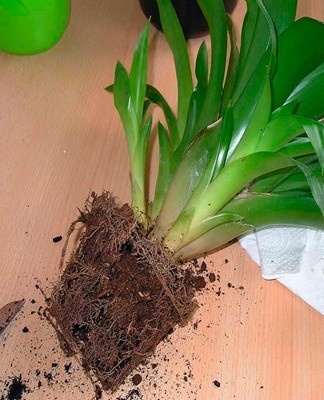
You have to wait a month and a half to two months until they have formed three or four leaves and a rhizome. Then follow these steps:
- After carefully separating the scion, plant it in a container filled with moss or a suitable substrate.
- Place the container in a dry, warm place with an air temperature of + 26-28 degrees.
- Put a clear cap or polythene bag on top.
The babies that form in the leaf axils
After the peduncle dries up, the children remain in the leaf sinuses of guzmania, which must be transplanted into separate flowerpots. They need to be transplanted after forming their own root system. The optimal season for transplanting is early spring.
To transplant children, you must:
- Together with the old plant, carefully remove it from the flowerpot.
- Carefully cut each of the children with a sharp knife so as not to disturb the newly formed root system.
- Lightly dry naturally.
- Treat young roots with a special growth stimulant.
- In a small pot with a height of up to 12 centimeters, successively lay out the drainage and the substrate.
- Plant and pour into an outlet.
- Cover with a plastic bag.
- Place in a shady place.
- When the young plants take root, move the flower pots to a naturally lit windowsill.
Seeds
This method involves the following actions:
- Fill the container with crushed sphagnum or peat with the addition of river sand.
- Rinse the seeds the day before sowing in a weak solution of potassium permanganate.
- Dry naturally.
- Sow evenly into the soil without covering.
- Maintain the temperature level in the room within + 22-24 degrees.
- After two months, harvest the seedlings in containers filled with a mixture of peat, leaf and turf in the proportions of 4: 2: 1.

In six months, the seedlings will become stronger and will be ready for a new transplant.
Diseases and pests
If the rules of care are violated, guzmania can develop some diseases inherent in indoor plants. In addition, the flower is more exposed to the actions of pests.
gray rot
Gray rot is a widespread fungal disease, with the development of which gray spots appear on the surface of the leaves of guzmania. Prompt treatment with fungicidal preparations will solve the problem.
Spider
A spider mite is a miniature insect pest that leaves a fine web on various parts of the plant. Other symptoms of infestation are dark brown spots that look like needle pricks and dry leaves. To combat the pest, it is recommended to use universal means - for example, "Aktellik", "Fitoverm" and "Akarin".
cochineal
The presence of a mealybug is evidenced by a waxy white, cotton-like bloom. In such cases, you should gently clean the plant with a soft brush or cotton swab dipped in soapy water. For spraying, a tincture of horsetail or garlic is suitable.
Shield
When damaged by a scabbard, brown seals with sticky contents appear on the leaves of the plant. To combat this insect, it is recommended to use a soft sponge dipped in a solution of tar soap - gently wipe each part of the guzmania with signs of damage.
Kinds
In total, there are about 130 species of guzmania in nature. Let's take a look at the most popular ones.
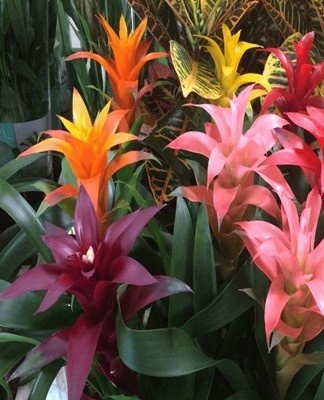
Reed
Guzmania reed is one of the most widely grown varieties at home. Its rosette consists of dense and wide linear green patches. In the middle is a colorful corolla, which can be easily confused with a flower.
Mauve
A bright plant with red, purple or scarlet inflorescences. The flowering period of such guzmania begins in September.
Ardent
The leaf plates of the rosette are directed to all sides of the upper hemisphere. Flowering from July to August. The bracts have a characteristic fiery color.
Ordinary
This type of guzmania blooms three times a year - in March, August and December. Its bracts are erect and have a red or pink tint.
Little
This variety of guzmania plant is characterized by the miniature size of the leaf plates. The bracts are lemon or red in color.
Modest
In this plant, the rosette consists of plates of green leaves. The bracts are light orange, with more pronounced and saturated tips.
Hybrid
The Guzmania hybrid mix is distinguished by smooth and wide leaves, as well as bright flowers that complement the rosette.

Ordinary
Guzmania Tempo differs from other varieties in a spreading rosette and golden-green color of the leaves.
Donella Smith
This variety has an erect peduncle and a loose rosette of scaly leaf plates. The flowering period begins in April-May. The inflorescences, pyramidal-paniculate in shape, are covered at the base with expressive red bracts.
Blood red
This species of Guzmania has a glass-like rosette made up of wide, linear leaves. The bracts are thin and colored dark red.
Bloody
The flowering period of this variety of guzmania begins in April and August. The bracts are rounded, pointed at the top.
short legs
A variety of guzmania with pointed bracts in the form of helmets.
Mosaic
The long leaf plates of the plant form a spreading rosette. The stipules on a straight peduncle have a dark pink color and the shape of a wide ellipse.
Musaica
Blooms in June and then in September. It is characterized by the presence of irregular lines on the surface of the green leaf plates.
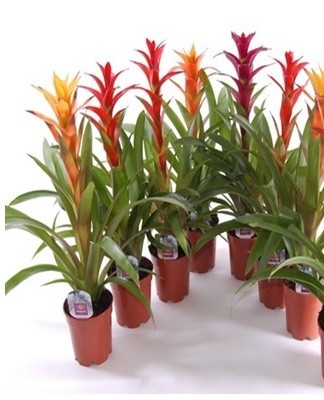
Concolor
Variety that resembles the previous one, except for a uniform and uniform color of the leaves.
Zebrina
This variety of guzmania is characterized by the presence of wide stripes on the outer surface of green foliage.
Nicaraguan
The foliage of the bush is characterized by a tongue-like shape that tapers upwards. At the bottom of the leaves, dense scales disappear over time and are replaced by longitudinal red strokes. The rosette of this variety of guzmania has a goblet shape, and the inflorescence is a simple spindle-shaped. In March and May, a few light yellow flowers are formed.
unicephalous
The rosette of this species of guzmania consists of many green and yellow leaves. In the lower part they are lighter, and in the upper part they are more saturated. The peduncle is bare, at the very top it is crowned with a spikelet with several rows of white flowers. The bracts in sterile individuals are red or white, and in those producing fruits, they are pale in color with longitudinal brownish risks.
Monostachia
A strong-leaved subspecies of guzmania, which blooms in June and July. The pale bracts have chocolate streaks.
Variegated
A plant with green leaves adorned with contrasting touches of white.
Alba
Guzmania variety characterized by strong green leaves. In the lower part are the same green bracts. The upper bracts are white in color.
Beneficial Features
According to bioenergetics, the guzmania plant has a beneficial effect on the energy atmosphere in the house, effectively cleans the air of harmful toxins and impurities, and also eliminates depressed moods.

